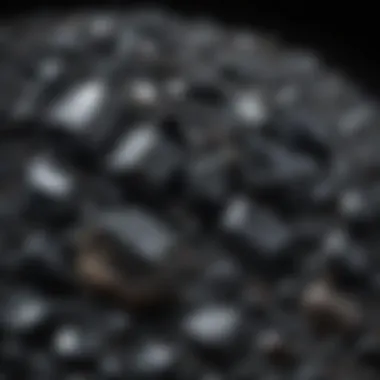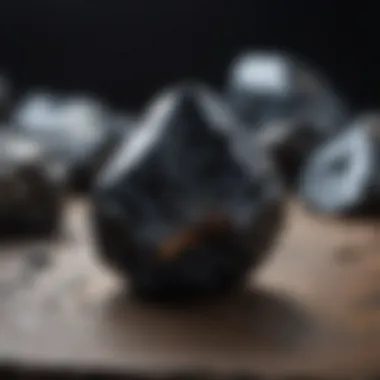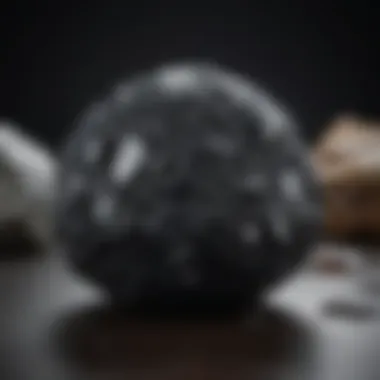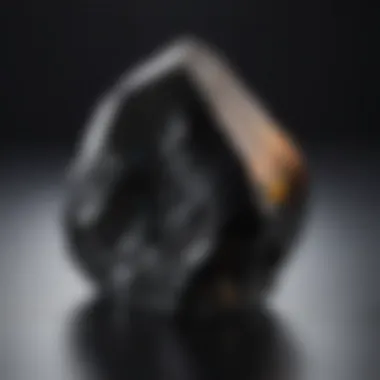Obsidian for Sale: A Comprehensive Guide


Intro
Obsidian is a unique volcanic glass that captivates collectors and historians alike. Its formation occurs when lava cools rapidly, resulting in a natural glass that typically comprises silica. Obsidian's texture and appearance make it a sought-after item among rock and fossil enthusiasts. This article provides a detailed exploration of obsidian, from understanding its origins to sourcing and valuing it effectively.
Whether you are a seasoned collector or new to the world of geological artifacts, comprehending obsidian's significance and intricacies is crucial. This guide will delve into key aspects such as the types of obsidian available, cultural relevance across different civilizations, and how to ensure authenticity when purchasing. Readers will find valuable insights to aid their collections and investments.
Topic Overview
Definition of the Collectible Rock
Obsidian is known for its glossy, glass-like surface and is primarily formed from volcanic activity. It is not a mineral but rather a natural glass resulting from the rapid cooling of lava that is low in water and gas content. The lack of crystal formation during consolidation gives obsidian its smooth texture. Those who collect stones and geological specimens often find obsidian appealing due to its aesthetic qualities and historical significance.
Brief History and Significance
The use of obsidian dates back thousands of years. Ancient civilizations, such as the Aztecs and the Mayans, utilized this material for tool-making and ceremonial purposes. Obsidian blades were favored for their sharp edges, which made them effective for cutting purposes. Today, obsidian holds both historical and cultural value, often featured in collections as an artifact of artistry and science. Its allure continues in modern contexts, where it is valued by collectors and artisans.
Identification and Classification
How to Categorize Items
Identifying the various types of obsidian is essential for collectors. Obsidian can be classified into categories based on its appearance and the presence of mineral inclusions. Common types include:
- Natural Obsidian – The standard black glass that displays a uniform appearance.
- Snowflake Obsidian – Characterized by white or gray inclusions that resemble snowflakes.
- Rainbow Obsidian – Exhibits colorful sheen caused by the presence of different minerals.
- Mahogany Obsidian – Displays reddish-brown tones with black swirls.
Understanding these varieties can enhance the interest in collecting obsidian.
Tips for Identifying Key Features
When assessing obsidian, observe the following features to determine authenticity and quality:
- Color – Look for deep, uniform colors that should not appear muddy or washed out.
- Texture – Genuine obsidian should have a smooth, glossy surface without bubbles or imperfections.
- Breakage Pattern – Authentic obsidian fractures with a conchoidal pattern, creating sharp edges and a glassy appearance.
By understanding how to identify and categorize different types of obsidian, collectors can make informed purchasing decisions and enhance their collections effectively.
Understanding Obsidian
Understanding obsidian is fundamental when navigating its multifaceted world. Obsidian, as a natural volcanic glass, carries both geological and cultural narratives. By grasping its properties and variations, collectors can make informed decisions, whether for personal enjoyment or investment. This section will provide essential insights into what obsidian is, how it forms, and the different types available in the market.
What is Obsidian?
Obsidian is a naturally occurring volcanic glass. It is formed when lava cools rapidly, preventing the formation of crystals. This rapid cooling results in a glassy texture, which is distinct and appealing. Obsidian is primarily composed of silica, which is responsible for its glassy appearance. It is often associated with volcanic activity and can be found in various colors and patterns, depending on its mineral content.
Formation and Geological Properties
Obsidian is primarily formed from the cooling of magma during volcanic eruptions. As lava erupts and flows, it can cool quickly when exposed to air or water. This quick cooling process allows obsidian to solidify in a glassy form. One noteworthy geological property is its conchoidal fracture, which creates sharp edges when broken. This characteristic made it valuable for creating tools in ancient times. Understanding these properties helps collectors appreciate obsidian’s uniqueness and its formation process.
Types of Obsidian
The variety in obsidian types is vast. Each type possesses specific characteristics, which can influence its appeal to collectors.
Black Obsidian
Black obsidian is perhaps the most recognized type. Its deep, solid color is captivating and gives it a sleek aesthetic. This type is often favored for jewelry and decorative items. The key characteristic of black obsidian is its uniform color and high polish capability. It is a popular choice due to its availability and affordability. Additionally, it is believed to have protective qualities, adding to its allure for potential buyers. However, the main disadvantage is its susceptibility to scratches, requiring careful handling.
Snowflake Obsidian
Snowflake obsidian is distinctive for its white or gray inclusions that resemble snowflakes. These patterns arise from the crystallization of mineral impurities in the volcanic glass. Its unique appearance makes it a desirable option for collectors and artisans alike. The primary advantage of snowflake obsidian is its aesthetic appeal, as it can be used in a variety of decorative pieces. However, like black obsidian, it can also show scratches more easily, so protective measures are advisable.


Rainbow Obsidian
Rainbow obsidian presents a unique feature: iridescent swirls of color that can appear when viewed from different angles. This occurs due to the light refraction within the glass. Its captivating appearance makes it a favorite among collectors who appreciate its optical characteristics. The advantage of rainbow obsidian lies in its visual complexity, which can elevate the value of any collection. Nonetheless, its rarity may make it more expensive and harder to source.
Mahogany Obsidian
Mahogany obsidian features a rich, reddish-brown color, often with black swirls. This type stands out for its warm tones and is often used in jewelry. The key characteristic is its unique color combination, which tends to attract those looking for distinct pieces. It serves as an excellent choice for those who value variety. The downside is that it may not be as readily available as black or snowflake obsidian, which can limit purchasing options.
Obsidian with Inclusions
Obsidian with inclusions encompasses varieties that contain other minerals or gas bubbles trapped during formation. These inclusions add character and uniqueness to each piece. Collectors often find these specimens intriguing due to their distinctiveness. The primary advantage is that they can showcase the natural processes involved in obsidian's formation. However, it’s crucial for buyers to be aware that inclusions can sometimes weaken the glass, potentially affecting durability.
Understanding these variants of obsidian is essential for collectors. It not only helps in identifying and sourcing these pieces but also enhances the appreciation for their unique qualities.
The Cultural Significance of Obsidian
Obsidian holds a place of distinction across various cultures and contexts. Its significance extends beyond the mere physical properties of the rock. Understanding its historical and cultural relevance offers collectors and enthusiasts a deeper appreciation for their obsidian pieces.
Historical Uses in Tools and Art
Historically, obsidian was valued for its sharpness and durability. Ancient civilizations recognized its potential for tool-making, resulting in a primary use in weaponry and daily implements. For example, the Aztecs utilized obsidian to craft blades, arrows, and spears, benefiting from its ability to achieve a fine edge. This practical application greatly assisted in survival and warfare.
Obsidian's qualities also enabled artisans to create intricate artistic pieces. Artifacts have been discovered showcasing the skill of ancient craftspeople, including figurines and jewelry. These items not only served functional purposes but also reflected the aesthetic values of their culture. The polished shine of obsidian became synonymous with beauty and refinement in many societies.
Furthermore, archaeological sites frequently yield obsidian tools. An example is the findings from the site of the ancient city of Teotihuacan in Mexico, where obsidian artifacts have been extensively studied. Such discoveries highlight the resource's vital role in the cultural and economic practices of pre-Columbian communities.
Symbolism in Different Cultures
In addition to its practical uses, obsidian has rich symbolic meanings. In many cultures, it embodies the duality of creation and destruction. It signifies protection, as it was often used to ward off negative energy and misfortune.
Many Native American cultures regard obsidian as a powerful stone. Tribes such as the Navajo and Apache have revered it for ritualistic purposes. It is believed to offer insights and guidance, acting as a mirror to one’s soul. The stone is often utilized in spiritual practices, reflecting the belief in its metaphysical properties.
Despite its sharp edges, obsidian is also associated with healing. It symbolizes change and transformation, offering emotional support during times of distress. This association contributes to its appeal amongst many collectors, who often seek not only a physical object but also its historical and cultural stories.
"Obsidian is more than just a rock; it is a connection to our past and a symbol of the human experience across time and space."
Understanding obsidian's cultural significance enhances the experience of collectors. Recognizing its history and symbolism infuses greater meaning into each piece, transforming mere collection into a journey of exploration and appreciation of human ingenuity and belief.
As one learns about the diverse importance of obsidian, it becomes clear that this volcanic glass harbors stories that transcend its geological essence, connecting us to the civilizations that cherished it.
Why Buy Obsidian?
Purchasing obsidian offers various benefits, especially for enthusiasts and investors. Understanding these factors helps in making informed decisions when acquiring this unique volcanic glass. Obsidian has a blend of aesthetic appeal, cultural significance, and investment potential that can enrich one's collection or serve as a strategic asset.
Collecting as a Hobby
Collecting obsidian can be a rewarding hobby for many. The diversity of types, colors, and patterns available keeps it engaging.
- Variety in Collection: Different types of obsidian, such as Black Obsidian or Snowflake Obsidian, provide a range of visual and textural experiences.
- Cultural Exploration: Each piece often carries historical or cultural significance, encouraging collectors to learn more about ancient uses of obsidian in tools and rituals.
- Community and Knowledge: Engaging with fellow collectors through forums or shows enhances the experience. Resources such as reddit.com host discussion threads that can offer advice and support.
For many, the thrill of hunting for rare pieces in rock shows or online marketplace adds to the enjoyment. The sense of accomplishment in featuring an exceptional find is a feeling that resonates among collectors.
Investing in Obsidian
Investing in obsidian presents unique opportunities. Although it may not have the same recognition as precious stones, the value of high-quality obsidian can appreciate over time. Factors to consider include:
- Rarity and Quality: Types such as Rainbow Obsidian or Mahogany Obsidian often fetch higher prices. Quality is assessed based on clarity, color, and form.
- Market Trends: Keeping an eye on price trends in the market influences investment decisions. Resources like en.wikipedia.org provide updates on the market dynamics.
- Limitations of Supply: As sourcing becomes more challenging in some regions, the value of already obtained pieces may rise.


Investing in obsidian requires careful consideration and research. Traditional gemstones have a well-established market, yet obsidian is gaining traction among collectors looking for diversification. With the right knowledge and approach, investors can find solid opportunities in this specialized market.
Sourcing Obsidian
Sourcing obsidian is crucial for both collectors and investors interested in this unique natural glass. Understanding where to find it, how to assess its quality, and being aware of ethical considerations are all significant aspects. The sources of obsidian can vary greatly in terms of quality, price, and authenticity. Thus, knowing the right places to buy, along with best practices for sourcing, is essential for building a reputable collection.
Where to Find Obsidian for Sale
Online Marketplaces
Online marketplaces are among the most accessible platforms for sourcing obsidian. Websites like eBay and Etsy provide extensive listings and allow collectors to find various types of obsidian. The key characteristic of online marketplaces is their vast selection, which can cater to both novice and experienced buyers.
One unique feature of these platforms is the ease of comparison shopping. Buyers can quickly view multiple sellers and their prices. However, the potential downside is the risk of misrepresentation, where the authenticity or quality of the obsidian may not meet expectations after purchase. Thus, it is important to check seller ratings and read customer reviews to prevent potential issues.
Rock and Mineral Shows
Rock and mineral shows provide an excellent opportunity for sourcing obsidian directly from sellers. These events often gather various vendors who specialize in rocks and minerals, making it easier for collectors to find quality pieces. A key characteristic of rock and mineral shows is the in-person interaction, allowing buyers to ask questions and inspect items closely before purchasing.
A unique feature of attending these shows is that many exhibitors are knowledgeable about their products. This can lead to valuable insights regarding the origin and quality of the obsidian you wish to buy. However, availability can be inconsistent, as these shows may only take place at specific times throughout the year.
Specialty Collectible Stores
Specialty collectible stores are another reliable avenue for sourcing obsidian. These dedicated shops focus on geological specimens, offering a curated selection of high-quality pieces. The key advantage of specialty stores is the expertise they typically employ. Staff members often possess extensive knowledge about obsidian and can help guide your purchasing decisions.
A unique feature of these stores is the assurance of quality. Many reputable shops have strict sourcing criteria, ensuring that customers receive genuine items. However, the downside can be higher prices compared to other sources, reflecting the quality and expertise offered.
Guidelines for Ethical Sourcing
Ethical sourcing is an integral aspect when sourcing obsidian. Buyers should consider the environmental impact and the fairness towards local communities involved in mining. Ensuring that obsidian is sourced responsibly not only preserves its beauty but also maintains its significance in various cultures.
Evaluating Obsidian Quality
Evaluating the quality of obsidian is a crucial aspect for both collectors and investors. Understanding what constitutes high-quality obsidian can significantly influence decisions regarding purchases and long-term value retention. Quality assessment involves considering multiple factors that determine the aesthetic and material properties of obsidian. Ensuring authenticity and recognizing genuine pieces from imitations also plays a critical role. This section aims to unpack the components that affect obsidian's value and the methods to establish authenticity.
Factors Influencing Value
Several factors determine the value of obsidian. Here are the key elements to consider:
- Color and Appearance: The variety of colors in obsidian can enhance its market value. For instance, black obsidian is often seen as classic, while rarer colors like rainbow or mahogany obsidian generally command higher prices.
- Inclusions and Patterns: Obsidian with aesthetically appealing patterns, such as snowflake or golden sheen inclusions, can also drive up value. The uniqueness of these patterns is critical in assessing worth.
- Size and Shape: Larger pieces tend to be more valuable. Natural shapes or well-crafted items also appeal more to collectors.
- Condition: The overall state of the obsidian piece matters. Chips, cracks, and scratches diminish its value substantially.
- Provenance: A known history of the piece, especially if it originates from specific locations renowned for their obsidian, can enhance its market value.
When considering a purchase, evaluating these factors can provide insight into the potential worth of the obsidian in question.
Identifying Authenticity and Genuineness
The authenticity of obsidian is paramount to ensuring that collectors invest in genuine pieces. Here are tips to help identify authentic obsidian:
- Know the Source: Understanding where the obsidian is sourced can often indicate authenticity. Certain regions, like the U.S. states of Oregon and Arizona, are known for high-quality obsidian.
- Examine the Surface: Authentic obsidian will have a glassy, smooth surface. If the surface appears dull or has a matte finish, it may be a synthetic imitation.
- Use a Lighter Test: A simple way to check is to use a lighter or flame. Genuine obsidian does not melt or bubble as easily as plastic imitations do.
- Look for Bubbles: Real volcanic glass should have minimal bubbles or inclusions. Numerous bubbles can suggest it is not natural obsidian.
"Authenticity in collecting is not just about the piece. It defines the collector's integrity and passion for the craft."
These methods serve as guideposts for collectors to ensure they are building a genuine collection without falling for imitations.
Understanding these details enhances the experience of collecting and investing in obsidian, ensuring that individuals make informed choices rooted in knowledge.
Maintenance and Care of Obsidian Items
Caring for obsidian items is essential for maintaining their aesthetic and intrinsic value. Obsidian is a sensitive material; its beauty can be compromised by improper handling and maintenance. Attention to cleaning and storage will preserve the item’s luster and durability. Ensuring good maintenance practices can enhance your collection significantly, keeping every piece not just in good condition, but also safe from damage.


Cleaning Techniques
Cleaning obsidian should be approached with caution. Here are some effective methods:
- Use soft cloths: Always use a soft, lint-free cloth to gently wipe the surface of your obsidian items. This reduces the risk of scratches.
- Mild soap solution: If deeper cleaning is needed, a mix of warm water and mild soap can be employed. Avoid harsh chemicals as they can harm the surface.
- Avoid abrasive materials: Steer clear of pads or brushes that may scratch the stone. Instead, an old toothbrush with soft bristles can be used for hard-to-reach areas. Remember to be gentle.
- Rinse with clean water: After cleaning, rinse the item carefully under clean, lukewarm water to remove any soap residue. This step is crucial to avoid sticky surfaces.
- Dry completely: Pat the item dry with a soft towel before storing it.
These cleaning techniques will help maintain the clarity and shine of your obsidian items, ensuring they remain attractive and valuable.
Storage Recommendations
Proper storage is vital for preventing damage and maintaining the quality of obsidian pieces. A few key guidelines include:
- Use padded storage boxes: Store obsidian items in soft-lined boxes, which offer protection against shocks and scratches.
- Avoid direct sunlight: Prolonged exposure to sunlight may fade or alter the appearance of obsidian. Keeping it in a cool, dark place is advisable.
- Separating items: If you have multiple obsidian pieces, ensure they are stored separately, whether wrapped in soft cloth or in distinct compartments. This prevents them from scratching against one another.
- Regular inspections: Check your stored items periodically for any signs of wear or damage. Early detection can save you from costly repairs or repurchasing a new piece.
These storage recommendations provide a proactive approach to maintaining your obsidian collection. With thoughtful care, each piece can remain a stunning part of your collection for years to come.
"Proper maintenance and care not only preserves obsidian items but also enhances their value to collectors."
By adopting these maintenance practices, you will be able to enjoy your obsidian collection without concerns about damage or degradation.
Current Market Trends for Obsidian
Understanding the current market trends for obsidian is crucial for both collectors and investors. The value of obsidian can fluctuate. Knowing these trends helps buyers make informed decisions. Additionally, it can enhance the effort of collectors looking to expand their collections and possibly realize gains in investments.
Price Trends Based on Type and Quality
When evaluating the price of obsidian, it is essential to consider the various types and their qualities. The prices can differ significantly based on these factors. For instance, standard black obsidian may be more accessible and more affordable. In contrast, rarer types like rainbow obsidian or snowflake obsidian can command much higher prices. Some specific areas to focus on include:
- Rarity: The rarer the type, the higher the price. Collectors are willing to pay more for unique specimens.
- Quality: This encompasses the clarity, color consistency, and lack of inclusions. High-quality pieces typically fetch better prices.
- Market Demand: Prices can increase as the popularity of obsidian rises among collectors and the general public.
In recent years, collectors have seen trends where specific types of obsidian increase in value more dramatically than others. Tracking these shifts can be beneficial for those looking to invest in obsidian.
Impact of Technology on the Obsidian Market
Technology's role in the obsidian market is becoming increasingly significant. Innovations have transformed how collectors source and evaluate obsidian. Several notable influences include:
- Online Marketplaces: Platforms like Etsy and eBay now allow easier access to global offerings. Collectors can find rare pieces from diverse locations. This expansion increases competition and can further impact pricing.
- Authenticity Verification: Advanced methods, including imaging and spectroscopy, help to establish the authenticity of obsidian. This can protect buyers from fakes and support sellers showcasing genuine pieces.
- Social Media: Forums and groups on platforms like Reddit and Facebook have built communities around obsidian collecting. Insights shared within these groups can influence market trends and create more informed buyers.
"Understanding technology's influence helps navigate the complexities of today's obsidian market, offering both challenges and opportunities for collectors."
In summary, monitoring obsidian’s market trends- from pricing based on type and quality to technology’s impact- provides valuable insights for collectors and investors alike.
Future of Obsidian Collecting
The future of obsidian collecting is a topic that warrants attention due to its ever-evolving nature and the various factors influencing collectors today. As more individuals recognize the aesthetic and historical value of obsidian, the collecting community can be expected to grow. This growth signifies not only an increase in interest but also the emergence of new trends that collectors must navigate.
Emerging Trends in Collecting
Understanding emerging trends is crucial for adapting collecting strategies. One noticeable trend is the shift towards eco-conscious collecting. As collectors become more aware of the environmental impact of sourcing obsidian, they may prefer ethically sourced stones. This preference can influence market availability and prices significantly. Collectors might increasingly seek sources that align with fair trade practices and environmental sustainability. Moreover, online platforms for purchasing obsidian are also evolving. More websites specialize in unique, high-quality pieces. Here, buyers can find curated selections of obsidian, enhancing their collection while supporting small businesses and artisans.
Another trend to watch is the growing importance of digital verification. As forgeries become more sophisticated, authenticating obsidian through digital means is likely to increase. Blockchain technology and certificates of authenticity are becoming pivotal in the marketplace. These tools provide both transparency and proof for buyers, ensuring the integrity of their purchases.
Potential Challenges for Collectors
Despite the promising aspects of future collecting, several challenges persist. A primary concern is the fluctuation in prices. As demand grows, prices might become unstable. Collectors need to stay informed about market conditions to avoid overpaying or investing in pieces that may not hold value in the future.
Additionally, geographical restrictions can pose a challenge. Some regions limit the export of natural resources, including obsidian. Understanding these regulations is necessary for collectors who source their pieces internationally. It is vital for collectors to stay informed about local and global policies affecting harvesting and selling obsidian.
Another significant issue is the risk of encountering imitation or fake products. The market is flooded with synthetic and altered specimens. Therefore, collectors should be knowledgeable about identifying genuine pieces and understanding the nuances of different obsidian types. Education on this topic cannot be underestimated in the face of increasing sophistication in imitation techniques.
"Collectors must adapt and educate themselves continuously to thrive in the dynamic world of obsidian collecting."
By being attuned to these emerging trends and potential challenges, collectors can position themselves strategically in the obsidian market. This proactive approach will enhance their future collecting experience, ensuring that they acquire valuable pieces that will stand the test of time.



